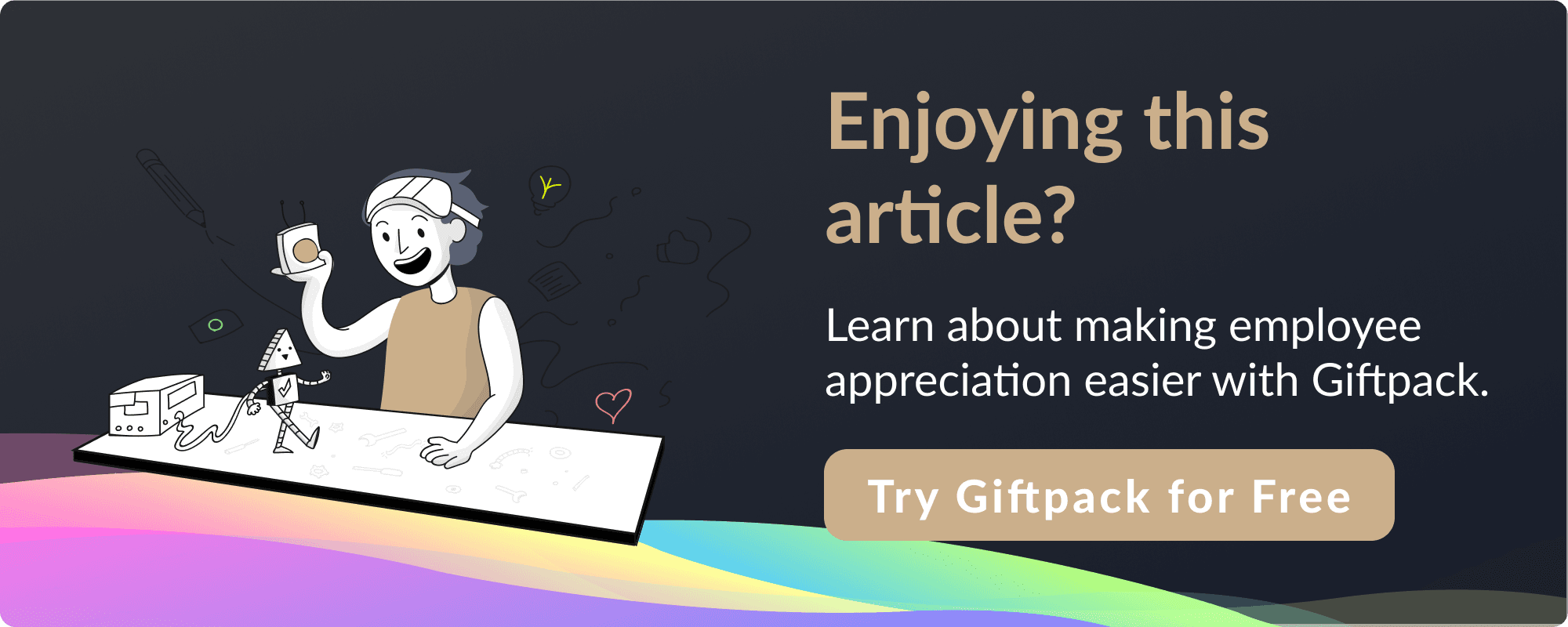
Welcome to our blog on employee rewards examples! In today's fast-paced and competitive business world, attracting and retaining top talent has become more important than ever. One of the most effective ways to do that is by implementing a comprehensive employee recognition program that includes a variety of rewards and incentives.
Employee rewards examples can range from small, day-to-day gestures like a handwritten thank-you note or a shout-out during a team meeting, to more substantial rewards such as bonuses, promotions, or even paid time off. But what makes a truly effective employee rewards program? How can you create a culture of recognition that motivates and engages your employees? And what are some innovative and creative employee rewards examples that can take your program to the next level? We'll explore all of these questions and more, so keep reading to discover how you can unleash the power of employee recognition.
74 Creative Employee Rewards Examples That You Should Try Out
Rewarding employees is essential for boosting morale, increasing engagement, and creating a positive work environment. The same old rewards can become predictable and lose their effectiveness over time. To keep your employees motivated and excited, it's important to get creative with your employee rewards. Here are 74 creative employee rewards examples that will make your team feel valued and appreciated.
1. "Gold Star" Recognition
Award employees with a gold star sticker or badge for going above and beyond their duties. This simple gesture can boost morale and motivate others to excel.
2. VIP Parking Spot
Reserve a prime parking spot for the employee of the month. It's a small gesture that can make a big impact.
3. Lunch with the CEO
Give employees the opportunity to have a one-on-one lunch with the CEO or a senior executive. This will show them that their contributions are valued at the highest level.
4. Personalized Office Supplies
Surprise employees with personalized office supplies, such as notebooks, pens, or coffee mugs with their name or a motivational quote.
5. Team Outing
Treat your team to a fun outing, such as a team-building activity, a trip to an amusement park, or a group dinner at a fancy restaurant.
6. Flexible Work Schedule
Allow employees to have flexible work hours or work from home on certain days. This shows trust and gives them greater control over their work-life balance.
7. Learning Opportunities
Invest in your employees' growth by providing them with access to online courses, workshops, or conferences in their area of interest.
8. Public Recognition
Acknowledge employees' achievements publicly, whether it's through a company-wide email, a social media shout-out, or a mention at a team meeting.
9. Wellness Program
Implement a wellness program that offers benefits like gym memberships, yoga classes, or on-site massages to promote employee well-being.
10. Surprise Treats
Surprise your team with treats like donuts, ice cream, or pizza to add some excitement to their day.
11. Travel Vouchers
Reward top performers with travel vouchers that they can use for a weekend getaway or a dream vacation.
12. Office Upgrade
Give employees the opportunity to upgrade their office space with new furniture, plants, or artwork.
###13. Volunteer Opportunities
Encourage employees to give back to the community by organizing volunteer events or offering paid time off for volunteering.
14. In-Office Happy Hour
Celebrate a successful project or milestone with an in-office happy hour, complete with drinks, snacks, and music.
15. Personal Development Allowance
Provide employees with a budget they can use to pursue personal development activities, such as attending a cooking class or learning a new language.
16. Team Building Retreat
Take your team on a retreat where they can bond, learn new skills, and recharge.
17. Employee of the Month Parking Spot
Designate a prime parking spot specifically for the employee of the month.
18. Lunchtime Yoga Classes
Offer on-site yoga classes during lunch breaks to help employees relax and recharge.
19. Bring Your Pet to Work Day
Allow employees to bring their furry friends to the office for a day of fun and stress relief.
20. Book Club
Start a company-wide book club where employees can discuss and share their favorite reads.
21. Personalized Thank-You Notes
Write personalized thank-you notes to employees, highlighting their specific contributions and expressing gratitude.
22. Surprise Bonus
Surprise employees with a monetary bonus for their exceptional performance or dedication.
23. Office Olympics
Organize a day of friendly competition and team-building activities, such as relay races, tug of war, and trivia.
24. Professional Development Mentorship
Pair employees with mentors who can provide guidance and support in their professional development.
25. Coffee with a Leader
Arrange informal coffee meetings between employees and company leaders to foster mentorship and connection.
26. Work Anniversary Celebrations
Celebrate employees' work anniversaries with a small gift, a personalized note, or a team lunch.
27. Innovation Awards
Recognize employees who come up with innovative ideas that drive the company forward.
28. Adventure Day
Plan an adventurous day filled with activities like hiking, kayaking, or zip-lining to inspire your team to step out of their comfort zones.
29. Service Anniversary Gifts
Reward employees' loyalty with meaningful gifts on their service anniversaries, such as personalized jewelry or a custom-made plaque.
30. Lunch and Learn Sessions
Invite guest speakers or industry experts to conduct lunchtime sessions where employees can learn and gain new insights.
31. Personalized LinkedIn Recommendations
Write thoughtful and personalized LinkedIn recommendations for employees to enhance their professional profiles.
32. Employee Recognition Wall
Create a wall where employees' achievements and contributions are displayed for everyone to see.
33. Surprise Time Off
Surprise employees with a spontaneous day off to recharge and spend time with their loved ones.
34. Quarterly Awards Ceremony
Host a quarterly awards ceremony to recognize outstanding employees in various categories, such as teamwork, innovation, and leadership.
35. Skill-Based Training
Provide employees with opportunities to develop new skills that are relevant to their roles or interests.
36. Employee Wellness Challenges
Organize challenges that promote healthy habits, such as step competitions, meditation challenges, or healthy eating contests.
37. Personal Assistant for a Day
Give employees the luxury of having a personal assistant for a day to help with their tasks and errands.
38. Technology Upgrade
Upgrade employees' work devices or provide them with the latest tech gadgets to enhance their productivity and efficiency.
39. Lunch with a Mentor
Arrange one-on-one lunches between employees and mentors who can provide guidance in their career development.
40. Recognition Wall of Fame
Create a digital wall of fame where employees' achievements and contributions are recognized and celebrated.
41. Monthly Team-Building Activities
Plan a monthly team-building activity, such as a cooking class, a scavenger hunt, or a bowling night.
42. Employee Appreciation Week
Dedicate a whole week to show appreciation for your employees, with daily surprises, treats, and special events.
43. Customized Swag
Create customized company swag, such as T-shirts, hoodies, or water bottles, with personalized designs or empowering messages.
44. Personal Styling Session
Offer employees a personal styling session with a professional stylist to boost their confidence and style at work.
45. Innovation Day
Dedicate a day for employees to work on innovative projects, explore new ideas, and present their findings to the rest of the team.
46. Skill Exchanges: Encourage employees to share their skills and knowledge with each other through skill exchanges or lunchtime workshops.
47. Surprise Desk Makeover
Give employees a surprise desk makeover with new decorations, plants, and organizational tools.
48. Employee Discount Program
Partner with local businesses to provide exclusive discounts to employees as a way to show appreciation.
49. Health and Wellness Reimbursement
Reimburse employees for their health and wellness expenses, such as gym memberships or fitness equipment.
50. Employee Art Showcase
Organize an art showcase where employees can display their artwork and share their creative talents with their colleagues.
51. Coffee Shop Gift Cards
Surprise employees with coffee shop gift cards to treat themselves to a nice cup of coffee or tea.
52. Commute Assistance
Offer employees assistance with their commuting expenses, such as gas cards, public transportation passes, or bike-sharing memberships.
53. Mentorship Lunch Program
Establish a mentorship lunch program where employees can have lunch with mentors from different departments or senior positions.
54. Time for Passion Projects
Dedicate a certain amount of time each week or month for employees to work on their passion projects or explore new interests.
55. Learning Lunches
Organize lunchtime sessions where employees can share their knowledge and expertise with their colleagues.
56. Movie Night
Host a movie night at the office or an outdoor location, complete with popcorn and snacks.
57. Health and Wellness Challenges
Organize challenges focused on improving employees' health and wellness, such as step challenges, healthy eating challenges, or meditation challenges.
58. CEO for a Day
Give employees the opportunity to be the CEO for a day, where they can make decisions, lead meetings, and experience the responsibilities of the top role.
59. Language Classes
Provide employees with the opportunity to learn a new language by offering language classes or online courses.
60. Personalized Video Messages
Record personalized video messages from leaders or colleagues, expressing gratitude and appreciation for employees' contributions.
61. Employee Podcast
Start an employee podcast where employees can share their insights, experiences, and stories with their colleagues.
62. Work-Life Balance Grants
Offer grants that employees can use to pursue activities that enhance their work-life balance, such as a wellness retreat or a family vacation.
63. Employee Art Wall
Create an art wall where employees can display their artwork and inspire creativity in the workplace.
64. Surprise Team Breakfast
Surprise your team with a delicious breakfast spread to kickstart their day on a positive note.
65. Gamification
Implement gamification elements in the workplace, such as leaderboards, badges, and rewards, to make work more fun and engaging.
66. Personal Development Library
Create a personal development library where employees can borrow books on various topics, such as leadership, communication, and personal growth.
67. Lunchtime Guest Speakers
Invite guest speakers to share their expertise and insights during lunchtime sessions, covering topics relevant to employees' personal and professional growth.
68. Employee Milestone Celebration
Celebrate employees' personal milestones, such as birthdays, weddings, or the birth of a child, with a small gift or a surprise celebration.
69. Virtual Team-Building Activities
Organize virtual team-building activities, such as online escape rooms, virtual trivia games, or virtual cooking classes, to keep remote teams connected and engaged.
70. Company Swag Store
Create an online store where employees can redeem points or tokens for company swag, allowing them to choose the items they want.
71. Personalized Training Plans
Develop personalized training plans for employees based on their career goals and areas for development.
72. Lunchtime Concerts
Arrange live music performances during lunch breaks to create a vibrant and relaxing atmosphere.
73. Surprise Team Retreat
Surprise your team with a spontaneous retreat to a destination of their choice, where they can relax, bond, and recharge.
74. Remote Work Equipment Allowance
Provide employees with a budget they can use to purchase equipment or furniture for their home offices, ensuring they have a comfortable and productive remote work setup.
There you have it, 74 creative employee rewards examples that will make your team feel valued and appreciated. The key to effective employee rewards is to personalize them and show genuine appreciation for your employee's hard work and contributions. Happy rewarding!
Related Reading
• How To Improve Employee Morale • How To Motivate Your Team • Benefits Of Employee Recognition • Why Is Employee Recognition Important • Employee Recognition Benefits • How To Improve Employee Satisfaction • Culture Of Recognition In The Workplace • Employee Recognition Statistics • Best Practices For Employee Recognition • Employee Anniversary Recognition
How Employee Rewards Contribute To Employee Motivation

Employee motivation and job satisfaction are crucial factors in maintaining a positive work environment and maximizing productivity. A key element in achieving these goals is the implementation of effective employee rewards programs. By recognizing and rewarding employees for their hard work and achievements, organizations can create a culture of appreciation and encourage employees to perform at their best. Let's explore how employee rewards contribute to motivation and job satisfaction.
1. Recognition and Appreciation
When employees receive recognition for their efforts, it boosts their self-esteem and makes them feel valued. Employee rewards provide a tangible way to acknowledge their contributions and show appreciation for their hard work. This recognition not only motivates employees to continue performing well but also enhances their job satisfaction by creating a positive work environment where their efforts are acknowledged and appreciated.
2. Incentives for High Performance
Employee rewards programs often include incentives for high performance, such as bonuses, commissions, or performance-based promotions. These incentives provide employees with a clear goal to strive for and fuel their motivation to excel. When employees see that their efforts are directly linked to tangible rewards, it increases their motivation to perform at a high level and achieve their goals. This, in turn, leads to job satisfaction as employees feel a sense of accomplishment and fulfillment when they are rewarded for their hard work.
3. Personal Growth and Development Opportunities
Employee rewards can extend beyond monetary incentives and include opportunities for personal growth and development. For example, organizations can offer employees the chance to attend conferences, workshops, or training programs as a reward for their outstanding performance. These opportunities not only enhance employees' skills and knowledge but also demonstrate the organization's investment in their professional growth. When employees feel supported in their personal development, it increases their motivation to excel and contributes to their overall job satisfaction.
4. Work-Life Balance Initiatives
Employee rewards can also encompass initiatives that promote work-life balance, such as flexible working hours, remote work options, or additional time off. These rewards recognize the importance of employees' personal lives and well-being, which can significantly impact their motivation and job satisfaction. By offering flexible work arrangements or additional time off, organizations demonstrate their commitment to creating a healthy work-life balance, which leads to happier and more satisfied employees.
5. Team Building and Collaboration Opportunities
Employee rewards can be designed to foster teamwork and collaboration. For example, organizations can provide team outings, group activities, or team-building workshops as rewards for achieving team goals or milestones. These rewards not only strengthen relationships among team members but also enhance job satisfaction by creating a sense of camaraderie and belonging. When employees feel connected to their team and enjoy working together, it increases their motivation and overall job satisfaction.
Employee rewards play a crucial role in motivating employees and enhancing their job satisfaction. By recognizing and appreciating employees' efforts, providing incentives for high performance, offering personal growth and development opportunities, promoting work-life balance, and fostering teamwork and collaboration, organizations can create a positive work environment where employees are motivated, engaged, and satisfied. Implementing a thoughtful and comprehensive employee rewards program is a win-win situation for both employees and the organization.
Best Practices for Designing and Implementing Effective Employee Rewards Programs

Designing and implementing effective employee rewards programs can be a challenging task for any organization. By following some best practices, you can create a program that not only motivates and engages your employees, but also helps drive performance and productivity. Let's explore some of these best practices below:
1. Clearly Define Program Objectives
Before implementing an employee rewards program, it is essential to clearly define the objectives you want to achieve. Are you looking to increase employee retention, boost sales performance, or promote a culture of innovation? By identifying your goals, you can tailor your rewards program to align with these objectives.
2. Align Rewards with Employee Preferences
To ensure the effectiveness of your rewards program, it is crucial to understand what motivates your employees. Conduct surveys or interviews to gather insights into their preferences and interests. Use this information to design a program that offers rewards that are meaningful and desirable to your employees.
3. Offer a Variety of Rewards
A one-size-fits-all approach to rewards may not be effective. Different employees have different preferences and motivations. Therefore, it is important to offer a variety of rewards, such as cash incentives, gift cards, paid time off, or even experiences like team outings or professional development opportunities. This allows employees to choose rewards that resonate with them personally.
4. Recognize and Celebrate Achievements
Recognition plays a significant role in motivating employees. Implement a system where employees' achievements and contributions are acknowledged and celebrated publicly. This can be done through a monthly or quarterly recognition program, where outstanding performers are rewarded with special incentives or public recognition.
5. Create a Transparent and Fair Process
Transparency and fairness are important factors in any rewards program. Clearly communicate the criteria and guidelines for earning rewards, so employees understand what they need to do to be eligible. Ensure that the selection process is fair and unbiased, taking into account factors like performance metrics, tenure, and individual contributions.
6. Foster Healthy Competition
Competition can be a powerful motivator. Incorporate elements of healthy competition into your rewards program, such as leaderboards, team challenges, or performance-based bonuses. This can create a sense of excitement and drive performance improvement among employees.
7. Regularly Evaluate and Refine the Program
Employee preferences and motivations may change over time. Therefore, it is crucial to regularly evaluate the effectiveness of your rewards program and make necessary adjustments. Seek feedback from employees and use data analytics to measure the impact of the program on key performance indicators. This will help you identify areas of improvement and refine the program to ensure its long-term success.
By following these best practices, you can design and implement an effective employee rewards program that not only motivates and engages your employees but also contributes to the overall success of your organization. A well-designed rewards program can be a powerful tool for driving performance and creating a positive work environment.
Related Reading
• Employee Recognition Awards • Employee Recognition Examples • Employee Rewards And Recognition • Employee Recognition Letter • Employee Recognition Day • Employee Rewards And Recognition Program Examples • Creative Employee Recognition Ideas • Employee Recognition Programs Examples • Recognition Examples For Employees • Examples Of Employee Recognition Awards • Employee Recognition Program Names • Types Of Employee Recognition • Employee Recognition Survey Questions • Employee Recognition Criteria • Employee Recognition Gifts • Employee Recognition Wall Ideas • Employee Recognition Gifts for Years of Service • Employee Recognition Points System • Virtual Employee Recognition Ideas
How Employee Rewards Programs Impact Employee Retention

Employee retention is a critical concern for companies in today's competitive job market. High turnover rates can be costly and disruptive to business operations. One effective strategy to address this challenge is to implement employee rewards programs. These programs provide incentives and recognition for employees, encouraging them to stay with the company. We will explore how employee rewards programs can impact employee retention rates.
1. Increasing job satisfaction
Employee rewards programs have a positive impact on job satisfaction. When employees feel appreciated and recognized for their hard work and achievements, they are more likely to be satisfied with their jobs. This satisfaction can lead to higher motivation and engagement, increasing their commitment to the organization and reducing the likelihood of turnover.
For example, a company can implement an Employee of the Month program, where the outstanding employee is publicly recognized and rewarded with a bonus or additional time off. This program not only motivates employees to perform better but also creates a sense of camaraderie and healthy competition among the workforce.
2. Fostering loyalty and commitment
Employee rewards programs foster loyalty and commitment among employees. When employees receive rewards and recognition, they develop a deeper connection to the organization. They feel valued and appreciated, which strengthens their commitment to the company's mission and goals.
For instance, a company can offer a loyalty program where employees earn points for their tenure and performance. These points can be redeemed for various rewards such as gift cards, paid vacations, or even company-sponsored events. This program not only incentivizes employees to stay with the company but also creates a sense of belonging and loyalty.
3. Improving work-life balance
Employee rewards programs can also contribute to improving work-life balance. Companies that prioritize employee well-being and offer rewards that support a healthy work-life balance are more likely to retain their employees.
For example, a company can implement a flexible work arrangement program where employees have the option to work remotely or adjust their working hours. This flexibility allows employees to better manage their personal responsibilities, leading to increased job satisfaction and reduced turnover.
4. Enhancing professional development
Employee rewards programs can also be designed to enhance professional development opportunities for employees. Companies that invest in their employees' growth and offer rewards such as training programs or tuition reimbursement are more likely to retain valuable talent.
For instance, a company can establish a mentorship program where high-performing employees are paired with senior leaders or industry experts. This program not only provides valuable guidance and learning opportunities but also demonstrates the company's commitment to employee development and growth.
Employee rewards programs can have a significant impact on employee retention rates. By increasing job satisfaction, fostering loyalty and commitment, improving work-life balance, and enhancing professional development, these programs create a positive work environment and encourage employees to stay with the company. Investing in employee rewards programs is a smart strategy for organizations looking to reduce turnover and retain their top talent.
How Employee Rewards Programs Impact Employee Retention

1. Building a Stronger Emotional Connection to the Company
When employees feel valued, they are more likely to develop an emotional connection to their workplace. Recognition programs that offer personalized rewards—rather than generic incentives—can deepen this sense of belonging. Employees who receive thoughtful gifts tailored to their interests, such as those provided by Giftpack’s personalized gifting platform, are more likely to stay long-term because they feel genuinely appreciated.
2. Enhancing Job Satisfaction and Workplace Morale
Rewards programs directly impact job satisfaction by reinforcing a positive workplace culture. Employees feel more fulfilled when they consistently receive recognition through meaningful perks like customized gifts, extra paid time off, or wellness programs. Companies that implement personalized gifting solutions, like those offered by Giftpack, ensure that rewards resonate with employees, leading to higher morale and increased retention.
3. Reducing the Appeal of Competitor Offers
One of the top reasons employees leave is the perception that better opportunities exist elsewhere. A well-executed rewards strategy can counteract this by providing exclusive perks and incentives that make staying with the company more appealing. When employees know they will be recognized and rewarded beyond salary increases, they are less likely to be tempted by outside offers.
4. Reinforcing Long-Term Commitment Through Milestone Rewards
Celebrating tenure with work anniversary gifts, performance-based bonuses, and loyalty incentives encourages employees to envision a future with the company. Organizations using Giftpack’s tailored corporate gifting options can reward employees with personally meaningful milestone gifts, reinforcing their importance to long-term success.
5. Strengthening Team Collaboration and Engagement
Employee rewards don’t just impact individuals—they foster team spirit and engagement. Programs that include team-based incentives, peer recognition, and group rewards encourage a collaborative work culture where employees feel a sense of shared achievement. Employees who feel valued within their team dynamic are far more likely to remain with the company.
6. Encouraging Career Growth and Professional Development
Offering learning-based rewards, such as tuition reimbursements, access to industry conferences, or skill-building programs, ensures employees see a future for growth within the company. By investing in employees' professional development, organizations show they are committed to their success, reducing the likelihood of them seeking career advancement elsewhere.
7. Personalized Gifting as a Retention Strategy
Generic rewards may provide a short-term boost, but personalized rewards leave a lasting impact. Custom-tailored gifts that reflect employees’ interests, hobbies, and personalities enhance the emotional value of recognition programs. With Giftpack’s AI-powered gifting solution, companies can effortlessly match employees with gifts they genuinely appreciate, making retention strategies more meaningful and impactful.

How To Measure The ROI of Your Employee Rewards Initiatives

When it comes to implementing employee rewards initiatives, organizations often invest significant time and resources. Without measuring the return on investment (ROI), it can be challenging to determine the effectiveness and success of these programs. Measuring ROI in employee rewards initiatives is crucial for organizations to make data-driven decisions, ensure the programs are achieving their intended goals, and justify continued investments.
Setting Clear Goals: Establishing Metrics for Success
To measure the ROI of employee rewards initiatives, organizations must first establish clear goals and metrics for success. These goals should align with the organization's overall objectives and be specific, measurable, achievable, relevant, and time-bound (SMART). By setting clear goals, organizations can track the impact of their rewards initiatives and assess whether they are meeting their intended outcomes.
Tracking Employee Engagement: An Indicator of Success
Employee engagement is a key factor in determining the effectiveness of employee rewards initiatives. By regularly monitoring employee engagement levels, organizations can gain insights into how their rewards programs are impacting employee satisfaction, motivation, and productivity. Surveys, feedback sessions, and performance reviews are some common methods used to track employee engagement. By comparing engagement levels before and after implementing rewards initiatives, organizations can quantify the impact and calculate the ROI.
Analyzing Performance and Productivity: Tangible Results
An effective way to measure the ROI of employee rewards initiatives is by analyzing performance and productivity metrics. By comparing key performance indicators (KPIs) such as sales revenue, customer satisfaction, and employee turnover rates, organizations can assess whether the rewards initiatives have led to tangible improvements. For example, if sales revenue increases after implementing a sales incentive program, it indicates a positive ROI on the rewards investment.
Cost Analysis: Balancing Investment and Returns
Another important aspect of measuring ROI in employee rewards initiatives is conducting a cost analysis. This involves evaluating the costs associated with implementing and maintaining the rewards programs, including program design, administration and rewards themselves. By comparing these costs to the benefits derived from improved employee engagement, productivity, and retention, organizations can determine whether the rewards initiatives are generating a positive ROI.
Long-Term Impact: Measuring Retention Rates
Employee rewards initiatives should not only focus on short-term results but also consider the long-term impact on employee retention. By analyzing retention rates before and after implementing rewards programs, organizations can determine whether the initiatives are effective in attracting and retaining top talent. Higher retention rates indicate a positive ROI, as it reduces recruitment and training costs associated with employee turnover.
Employee Feedback: The Human Element
Organizations should gather employee feedback to gain qualitative insights into the impact of rewards initiatives. Conducting focus groups, one-on-one interviews, or anonymous surveys can provide valuable feedback on the perceived value and effectiveness of the rewards programs. Understanding employees' perspectives can help organizations refine their initiatives, align them with employee needs, and further improve the ROI.
Measuring the ROI of employee rewards initiatives is essential for organizations to evaluate the effectiveness of their programs and justify the investments made. By setting clear goals, tracking employee engagement, analyzing performance and productivity, conducting cost analysis, measuring retention rates, and gathering employee feedback, organizations can gain a comprehensive understanding of the impact and returns generated by their rewards initiatives. This data-driven approach allows organizations to optimize their programs, improve employee satisfaction, and maximize ROI.
Potential Challenges That You Might Experience For Your Employee Rewards Program & How To Mitigate Them

Implementing employee rewards programs can be an effective way to motivate and engage employees, but it's not without its challenges. We will explore some of the potential pitfalls that organizations may face when implementing these programs and provide strategies to mitigate them.
1. Lack of Alignment with Organizational Values and Goals
When designing employee rewards programs, it is crucial to ensure that the rewards are aligned with the organization's values and goals. If the rewards do not resonate with employees or are perceived as incongruent with the company's mission, they may not be effective in motivating employees.
Mitigation Strategy
To mitigate this challenge, organizations should involve employees in the design process of the rewards programs. By soliciting feedback and suggestions, companies can ensure that the rewards align with employees' values and aspirations. Regularly communicating the connection between the rewards and the organization's goals can help employees understand the significance of their efforts.
2. Lack of Clarity and Transparency
Another challenge that organizations may face is a lack of clarity and transparency in their employee rewards programs. Employees need to understand the criteria for earning rewards and how the rewards are determined. Without clear guidelines, there is a risk of favoritism or perceived bias, which can lead to disengagement and resentment among employees.
Mitigation Strategy
To mitigate this challenge, organizations should establish clear and transparent criteria for earning rewards. It is essential to communicate these criteria effectively and ensure that they are consistently applied. Regularly updating employees on their progress towards earning rewards can also help maintain transparency and keep employees motivated.
3. Limited Budget
Budget constraints can pose a significant challenge when implementing employee rewards programs. Organizations may struggle to allocate sufficient funds to provide meaningful rewards, especially in times of financial uncertainty.
Mitigation Strategy
To overcome this challenge, organizations can focus on non-monetary rewards, such as recognition programs or professional development opportunities. These rewards can be just as effective in motivating employees and can be implemented without significant financial investments. Organizations can consider leveraging resources from external partners or sponsors to expand the range of rewards available to employees.
4. Lack of Customization
Every employee has unique needs and preferences when it comes to rewards. Implementing a one-size-fits-all approach may not effectively motivate all employees. Lack of customization can lead to disengagement and a sense of disconnect from the rewards program.
Mitigation Strategy
To address this challenge, organizations should consider offering a variety of reward options that cater to different preferences. Conducting surveys or feedback sessions with employees can help identify their preferred rewards and ensure that the rewards program is tailored to their needs. Providing flexibility in reward selection can also empower employees to choose rewards that are most meaningful to them.
5. Inconsistent Implementation and Follow-through
Consistency is crucial in maintaining the effectiveness of employee rewards programs. Inconsistencies in implementing the program or lack of follow-through on promised rewards can undermine the program's credibility and diminish its impact.
Mitigation Strategy
To mitigate this challenge, organizations should establish clear guidelines and procedures for implementing the rewards program. Regularly monitor the program's effectiveness and address any gaps or inconsistencies promptly. Providing timely feedback and recognition to employees who have earned rewards can also serve as a reinforcement mechanism and ensure consistent follow-through.
Implementing employee rewards programs can be a powerful tool for enhancing employee motivation and engagement. By addressing potential challenges and pitfalls such as lack of alignment, lack of clarity, limited budgets, lack of customization, and inconsistent implementation, organizations can create effective and successful rewards programs that drive employee performance and satisfaction.
Get Inspiration From Employee Rewards Programs Across The Globe

When it comes to employee rewards programs, there is no one-size-fits-all approach. Different industries and geographic regions have their own unique characteristics and priorities, which influence the design and implementation of these programs. Let's explore how employee rewards programs differ across industries and geographic regions.
1. Technology Industry: Embracing Innovation and Flexibility
In the technology industry, where competition for top talent is fierce, employee rewards programs tend to focus on innovation and flexibility. Examples of rewards in this industry may include flexible work arrangements, unlimited vacation policies, professional development opportunities, and stock options. Technology companies understand that attracting and retaining top talent requires offering perks that align with the industry's fast-paced and ever-evolving nature.
2. Healthcare Industry: Prioritizing Work-Life Balance and Wellness
In the healthcare industry, where long hours and high-stress levels are common, employee rewards programs often focus on work-life balance and wellness. Examples of rewards in this industry may include generous paid time off policies, on-site fitness centers, access to mental health resources, and sabbatical programs. Healthcare organizations recognize that taking care of their employees' physical and mental well-being ultimately leads to better patient care.
3. Manufacturing Industry: Recognizing Performance and Safety
In the manufacturing industry, where efficiency and safety are paramount, employee rewards programs emphasize performance recognition and safety initiatives. Examples of rewards in this industry may include performance-based bonuses, safety-related incentives, recognition programs, and opportunities for career advancement. Manufacturing companies understand the importance of motivating their employees to achieve high productivity levels while maintaining a safe working environment.
4. Financial Industry: Focusing on Financial Incentives and Benefits
In the financial industry, where monetary rewards are highly valued, employee rewards programs often revolve around financial incentives and benefits. Examples of rewards in this industry may include performance-based bonuses, profit-sharing plans, retirement savings programs, and comprehensive health insurance coverage. Financial institutions recognize that offering attractive financial rewards can be a significant motivator for their employees to achieve high levels of performance.
5. Geographic Regions: Cultural Considerations and Local Customs
Employee rewards programs also vary across geographic regions due to cultural considerations and local customs. For example, in some countries, paid parental leave and childcare support may be more prevalent, while in others, flexible work arrangements and remote work options may be more common. Understanding the cultural norms and local expectations is crucial for designing effective employee rewards programs that resonate with employees in different regions.
Employee rewards programs are not one-size-fits-all solutions. They differ across industries and geographic regions based on the unique characteristics and priorities of each. By tailoring rewards programs to cater to the specific needs and preferences of employees, organizations can create a positive work environment that attracts and retains top talent.
Employers may also find great value in incorporating employee rewards software, creating a seamless and meaningful way to acknowledge and inspire their teams. This software serves as a central hub for recognizing individual achievements, milestones, and contributions, fostering a culture of gratitude. Through personalized rewards and acknowledgment, employers can uplift morale, enhance employee satisfaction, and nurture a more engaged workforce. The user-friendly nature of the software also simplifies the tracking and management of reward programs, ensuring fairness and promoting a positive work atmosphere. In essence, the adoption of employee rewards software contributes to a harmonious work environment, elevates employee motivation, and positively influences overall team dynamics.
Related Reading
• Employee Recognition Cards • Employee Recognition Program Guidelines • Employee Recognition Companies • Employee Recognition Software • Employee Recognition Platform • Recognition Email To Employee • Gift Cards For Employee Recognition
Make your gifting efficient and improve employee attrition rates with Giftpack AI
Visit our product page to unlock the power of personalized employee appreciation gifts.